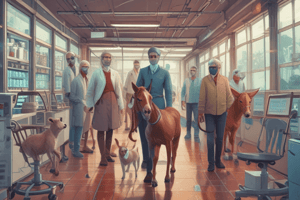Podcast
Questions and Answers
What is the primary means of transmission for influenza?
What is the primary means of transmission for influenza?
- Airborne transmission through droplet nuclei (correct)
- Direct contact with an infected individual
- Vector transmission through an intermediate animal host
- Contaminated food and water
Which of the following is an example of a vector transmission disease?
Which of the following is an example of a vector transmission disease?
- Malaria (correct)
- Ringworm
- Salmonella
- HIV/AIDS
What is the primary mechanism of transmission for tuberculosis?
What is the primary mechanism of transmission for tuberculosis?
- Contaminated environmental surfaces
- Direct contact with an infected individual
- Vector transmission through an intermediate animal host
- Airborne transmission through droplet nuclei (correct)
Which of the following is an example of an indirect transmission disease?
Which of the following is an example of an indirect transmission disease?
What is the primary means of transmission for herpes simplex virus?
What is the primary means of transmission for herpes simplex virus?
Which of the following is an example of a direct transmission disease?
Which of the following is an example of a direct transmission disease?
What is the primary mechanism of transmission for measles?
What is the primary mechanism of transmission for measles?
Which of the following is an example of an airborne transmission disease?
Which of the following is an example of an airborne transmission disease?
Flashcards are hidden until you start studying
Study Notes
Mode of Transmission
Airborne Transmission
- Occurs when pathogens are transmitted through the air
- Pathogens can be in the form of droplet nuclei, dust, or aerosols
- Examples:
- Influenza
- Tuberculosis
- Measles
- Can occur through:
- Coughing or sneezing
- Talking or singing
- Aerosol-generating medical procedures
Vector Transmission
- Occurs when pathogens are transmitted through an intermediate animal or arthropod host (vector)
- Vectors can be:
- Insects (e.g., mosquitoes, ticks)
- Arachnids (e.g., mites, spiders)
- Examples:
- Malaria (mosquito vector)
- Lyme disease (tick vector)
- Dengue fever (mosquito vector)
Direct Transmission
- Occurs when pathogens are transmitted through direct contact between an infected individual and a susceptible host
- Can occur through:
- Skin-to-skin contact
- Mucous membrane contact
- Direct contact with infected bodily fluids
- Examples:
- HIV/AIDS
- Herpes simplex virus
- Ringworm
Indirect Transmission
- Occurs when pathogens are transmitted through a contaminated intermediate object or substance
- Can occur through:
- Contaminated food and water
- Fomites (e.g., utensils, clothing)
- Environmental surfaces
- Examples:
- Food poisoning (e.g., Salmonella, E. coli)
- Waterborne diseases (e.g., Cholera, Giardiasis)
- Hospital-acquired infections (e.g., MRSA, C. difficile)
Modes of Transmission
Airborne Transmission
- Airborne transmission occurs when pathogens are transmitted through the air
- Pathogens can exist in the air as droplet nuclei, dust, or aerosols
- Examples of airborne diseases include influenza, tuberculosis, and measles
- Airborne transmission can occur through coughing or sneezing, talking or singing, or aerosol-generating medical procedures
Vector Transmission
- Vector transmission occurs when pathogens are transmitted through an intermediate animal or arthropod host (vector)
- Vectors can include insects (e.g., mosquitoes, ticks) or arachnids (e.g., mites, spiders)
- Examples of vector-borne diseases include malaria (mosquito vector), Lyme disease (tick vector), and dengue fever (mosquito vector)
Direct Transmission
- Direct transmission occurs when pathogens are transmitted through direct contact between an infected individual and a susceptible host
- Direct transmission can occur through skin-to-skin contact, mucous membrane contact, or direct contact with infected bodily fluids
- Examples of diseases spread through direct transmission include HIV/AIDS, herpes simplex virus, and ringworm
Indirect Transmission
- Indirect transmission occurs when pathogens are transmitted through a contaminated intermediate object or substance
- Indirect transmission can occur through contaminated food and water, fomites (e.g., utensils, clothing), or environmental surfaces
- Examples of diseases spread through indirect transmission include food poisoning (e.g., Salmonella, E. coli), waterborne diseases (e.g., Cholera, Giardiasis), and hospital-acquired infections (e.g., MRSA, C. difficile)
Studying That Suits You
Use AI to generate personalized quizzes and flashcards to suit your learning preferences.




